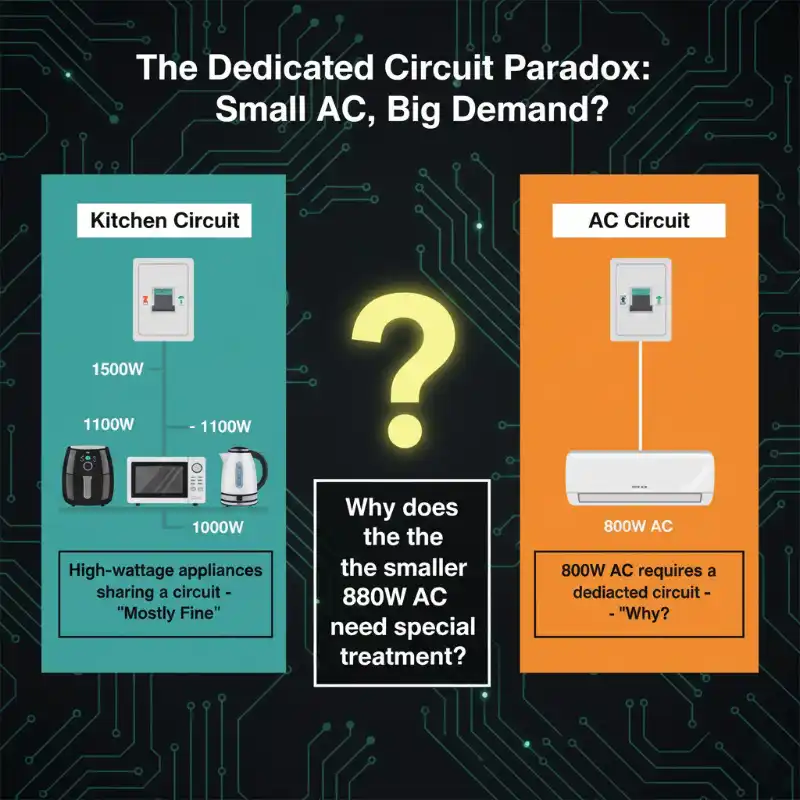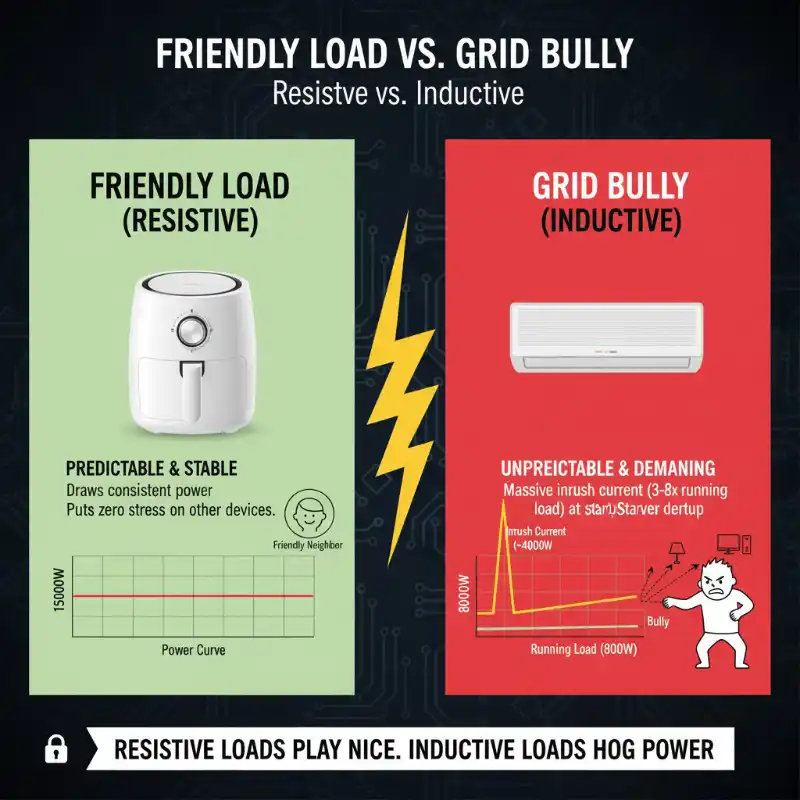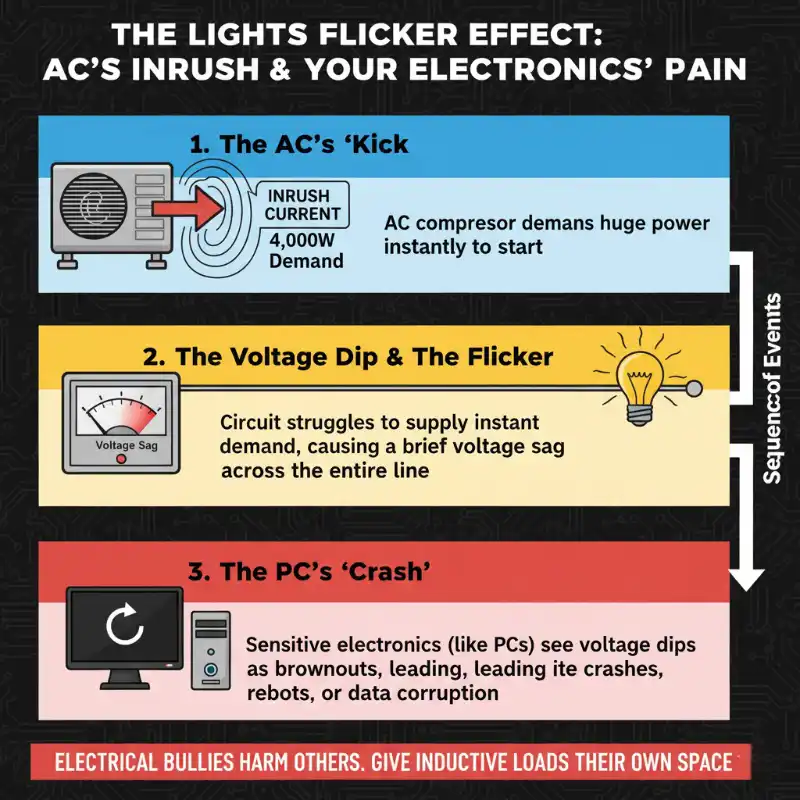This question is a classic. It’s one of the most logical, “common sense” pieces of pushback an engineer like me ever hears:
“This makes no sense. You’re telling me my tiny 800-watt air conditioner needs a whole dedicated circuit?
“Right now, my 1500-watt air fryer, 1100-watt microwave, and 1000-watt kettle all share a circuit in the kitchen, and it’s mostly fine.
“This feels like a double standard. Why is the 800W appliance the ‘problem’?”
This is not a “dumb” question. It’s a brilliant one. And the answer is the single best way to understand the “invisible” drama that happens inside your walls every single day.
The short answer is: You are comparing a “friendly” appliance to a “grid bully.”
Your 1500W air fryer is a “friendly” load. Your 800W air conditioner is a “bully” that starves its neighbors, and the “dedicated circuit” isn’t a privilege—it’s an isolation cell to protect your other electronics from it.
Let’s unpack this.
1. The “Friendly Load”: Your 1500W Air Fryer
First, let’s talk about your air fryer, kettle, or toaster. These are ප්රතිරෝධී බර.
This is a fancy term for a “dumb” heating element. They are, electrically, the perfect citizens.
- Their Behavior: When you turn on your 1500W air fryer, it draws… 1500W. When it runs, it draws 1500W. When it shuts off, it’s at 0W.
- The Power Curve: It’s a flat, boring, beautiful line. It’s predictable. It’s stable.
- The Impact: It places zero stress on other devices. It’s a “friendly load.”
Your kitchen circuit can handle this (to a point). And that “mostly fine” feeling? That’s the breaker’s thermal delay. It will let you pull 20A on a 16A circuit for a few minutes before it gets hot enough to trip. It’s designed to ignore brief, minor overloads.
2. The “Grid Bully”: Your 800W Air Conditioner
Now, the AC. That 800W rating? It’s a “lie.”
Well, it’s not a lie, but it’s only part of the truth. That’s the Running Load. It’s the power the AC uses after it’s already up and running.
But an AC is not a “dumb” heater. It’s an Inductive Load. It has a compressor, which is a powerful motor.
And motors, my friend, have a dark secret.
This secret is called Inrush Current, or more technically, “Locked Rotor Amps” (LRA).
- The Problem: A motor at rest (0 RPM) is like a dead short. The instant you tell it to start, it needs a massive kick of energy to overcome inertia and get spinning.
- The Numbers: That 800W running load? It’s “devil” at startup can be 3 to 8 times its running current.
- The Math: Your “800W angel” (which draws ~3.6A on a 220V line) can become a 4,000-watt “devil” (drawing ~18A) for the first 0.5 to 1 second of its life.
This is the “bully” in action.
3. The “Lights Flicker” Effect (And Why Your PC Hates It)
Now we can see the real problem.
You don’t have an 800W AC and a 400W PC on the same circuit.
You have a 4,000W Grid Bully and a 400W Sensitive Victim on the same circuit.
Here’s what happens every 15 minutes when the AC’s thermostat kicks the compressor on:
- The “Kick”: The 800W AC compressor demands 4,000W of power from the line. Right. Now.
- The “Voltage Dip”: The circuit cannot supply this instant, massive demand without a struggle. The “bully” sucks all the electrical “air” out of the room. The voltage on the entire circuit plummets for a fraction of a second.
- The “Flicker”: This is what you see. Your lights dim for a half-second.
- The “Crash”: This is what your 400W PC feels. That voltage dip is a “brownout” to its sensitive power supply. The PC sees it as a catastrophic power failure and shuts down, reboots, or corrupts data.
- The “Calm”: A second later, the compressor is up to speed. It “lets go” of the grid, and its load drops back to a “friendly” 800W. Everything seems normal… until 15 minutes later, when the cycle repeats.
Pro-Tip #1: This is not a “maybe.” It’s physics. This “inrush” is also why a dirty or failing AC is worse. If the compressor struggles, it stays in that “high-draw” state for longer, generating more heat and stress.
4. The Horror Story: Why This Is a Fire Hazard
“Okay,” you say, “so my PC will crash. I’ll just put the PC in another room. But the AC itself is ‘only’ 800W. It’s not a fire hazard, right?”
Wrong.
That “bully” behavior doesn’t just crash PCs. It melts outlets.
I was at a service call just last week. A client’s AC was plugged into a regular wall outlet. The outlet burned. Not “tripped the breaker.” It burned.
When I pulled the outlet from the wall, the “back-stabbed” neutral wire’s insulation was completely vaporized for an inch up the wire. The heat from the constant cycling of that compressor, pulling a massive load at the connection point, was so high that it simply incinerated the plastic.
Why didn’t the breaker trip? Because the “bully’s” 18A inrush was just under the 20A breaker limit, but the heat it generated at that tiny, cheap connection point was more than the plastic could handle.
The breaker is protecting the wire. It is not protecting the cheap 50-cent outlet you’re plugging into.
Pro-Tip #2: A dedicated circuit (and a proper, heavy-duty outlet) ensures that the entire path—from the panel to the plug—is designed to handle the “devil” inrush current, not just the “angel” running current.
Conclusion: The “Isolation Cell”
So, let’s go back to your question.
Why does the 800W AC get a “dedicated circuit” while the 1500W air fryer doesn’t?
- The 1500W “friendly” air fryer can share a circuit because it plays nice with others.
- The 800W “bully” AC needs an “isolation cell” (a dedicated circuit) because it harasses, starves, and endangers every other appliance that shares its line.
You are not “pampering” your AC. You are quarantining it.
You are putting the 4,000W “devil” in its own cell, so that when it rages, it can only flicker its own lights and stress its own heavy-duty outlet—and the rest of your house (especially your sensitive computer) can live in peace.
තාක්ෂණික නිරවද්යතාව සටහන
ප්රමිතීන් & ආරංචි මාර්ග නමෙන්ම: This article is based on the fundamental electrical principles of Inductive vs. Resistive loads and Inrush Current (LRA) in motors, as defined by NEMA (National Electrical Manufacturers Association) and NEC (National Electrical Code) principles.
Disclaimer: Always follow your local electrical code. In most jurisdictions (including the US NEC), all fixed-in-place air conditioners require a dedicated circuit, regardless of wattage.
එයට වඩා පළල් ප්රකාශය: All protection principles are accurate as of November 2025.








